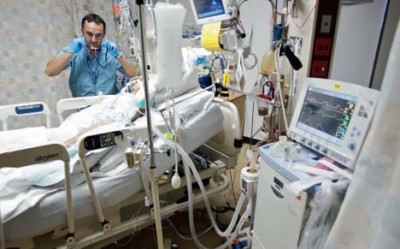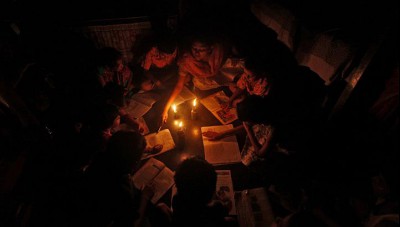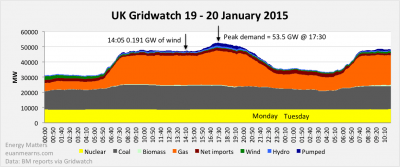
power debacle, you’ll soon be freezing in the dark.
****
The hackneyed myth that wind power “powers” millions of homes with wonderful “free” wind energy is taking a beating around the globe (see our post here).
The idea that a wholly weather dependent power generation source can ever be – as is touted endlessly by the wind industry and its parasites – an “alternative” to conventional generation is, of course, patent nonsense.
If there wasn’t already a complete power generation system built around on-demand sources, such as gas, coal, nuclear or hydro – then a country trying to run on wind power would – unless it was keen to revisit (or remain in) the stone age – inevitably need to build one (see our post here). So far, so insanely costly, and utterly pointless.
Now, just when winter starts to bite, and the Brits are looking for some extra sparks to toast their crumpets, brew their tea, to warm their homes and keep the icicles from their noses and toes, their massive fleet of blade-chucking, pyrotechnic, sonic-torture devices has completely downed tools – proving once and for all that wind power is the greatest fraud of all time.
Here’s The Telegraph with, yet another tale of just why it is so.
Electricity demand hits highest this winter – as wind power slumps to its lowest
The Telegraph
Emily Gosden
20 January 2015
UK electricity demand hit its highest level this winter on Monday – while wind turbines generated their lowest output, official figures show.
Cold weather saw UK demand hit 52.54 gigawatts (GW) between 5pm and 5.30pm, according to National Grid.
At the same time, low wind speeds meant the UK’s wind turbines were producing just 573 megawatts of power, enough to meet only one per cent of demand – the lowest of any peak period this winter, Telegraph analysis of official data shows.
Earlier on Monday wind output had dropped even lower, generating just 354 megawatts at 2pm, or 0.75 per cent of Britain’s needs – the lowest seen during any period this winter.
The analysis will fuel concerns that despite receiving billions of pounds in subsidies, Britain’s wind farms cannot be relied upon to keep the lights on when they are needed the most.
Britain now has about 12 GW of wind capacity installed on and offshore – meaning during Monday’s peak demand period, wind farms were generating less than five per cent of their theoretical maximum output.
Gas, coal and nuclear power plants instead provided the vast majority of the UK’s electricity needs.
A spokesman for National Grid said that Britain’s spare margins – the safety buffer between supply and demand – had remained “adequate”.
On average, UK wind farms produce about 28 per cent of their theoretical maximum power output.
But critics warn that cold snaps when demand soars can often coincide with periods when the wind doesn’t blow.
They argue that Britain’s energy security will become ever more precarious as old coal and gas power plants are closed and the country becomes more reliant on intermittent wind farms.
Dr Lee Moroney of the Renewable Energy Foundation, a think tank critical of wind farms, said: “Low wind speeds frequently accompany low temperatures as happened yesterday.
“The proliferation of wind farms encouraged by Government policy is misguided because a reliance on wind energy in these conditions leads to inevitable extra costs for consumers.
“Either reliable backup electricity supply from conventional sources must be provided when the wind does not blow, or extra costs in the form of constraint payments are incurred when there is too much wind on the system. It is a lose-lose situation for consumers.”
National Grid’s data, which covers the period since December 1, shows that the second highest peak demand – 50.9GW on December 4 – also coincided with the second lowest peak wind contribution, at just 1.5 per cent.
However other periods of particularly high peak demand, such as the evenings of December 9 and 10, coincided with much higher wind power output, with turbines meeting 18 per cent of demand.
The data also shows that Christmas Day was the only day when solar panels contributed anything at all to peak demand – because it was the only day when peak demand fell in daylight hours.
Demand on December 25 peaked after 12.30pm as families cooked their Christmas dinners.
On all other days demand peaked after it got dark – the vast majority between 5pm and 5.30pm.
Ministers were last year forced to approve a series of emergency powers to help prevent blackouts this winter, by firing up old power plants or paying factories to switch off.
National Grid said it had not yet needed to use any of the emergency powers.
Jennifer Webber, director of external affairs for wind industry body RenewableUK, said: “It’s wrong to cherry-pick statistics for short periods when the wind didn’t blow, as they’re unrepresentative of the full picture of the benefits wind provides for the UK.
“To get a proper idea of how well wind is performing as a vital part of our energy mix, you have to look at National Grid’s official figures over a meaningful period. In December, wind energy provided a record monthly high of 14 per cent of all the UK’s electricity needs.
“As a whole, 2014 was wind energy’s most productive year so far in this country, generating nearly 10 per cent of Britain’s electricity – equivalent to the annual demands of a quarter of all British homes.”
A spokesman for the Department of Energy and Climate Change said: “We need a diverse energy mix to reduce our reliance on imported fossil fuels and renewables, including wind, are helping us to achieve this.
“Over £10bn was invested in clean energy in 2014 and the sector could also support up to 200,000 jobs by 2020.”
The Telegraph
Another fine piece of “doublethink” and “doublespeak” from wind industry spin-kings, Renewable UK and DECCs – in the other-worldly, Orwellian tradition under which they operate; and which they deploy in their efforts to control the energy ‘game’ (see our post here).
When the hard numbers see it pressed on its central claim about “powering” millions of homes, the wind industry and its parasites start back-pedalling at a full pelt, whine about “cherry-picking data” and resort to waffle about ‘averages’, ‘overall benefits’ etc, etc (that’s if they haven’t already run off and hidden from their interlocutors – see our post here).
And, in this case – resorting to their classic “hey, quick look over there” tactic – the spinners pitch up the well-worn lie about wind power ‘investment’ creating hundreds of thousands of new jobs (see our post here); as if that will be some kind of consolation when Brits are all left freezing in the dark.
STT just loves their exhortation about the need to measure wind power output “over a meaningful period”, which, apparently, means “averaging” wind power output over a month or more.
Funny, you know, that power punters – selfish lot that they are – tend to consider having power available when they need it, as a “here and now” kind of thing. So let’s see how things are “averaging” out over at the ICU:

****
DECCs and Renewable UK are obsessed with the ultimate (nonsense) goal of Britain running exclusively on wind power – and every malicious move they make is aimed at seeing wind power totally ‘displace’ fossil fuel generation sources.
If their (impossible) ‘dreams’ were ever realised, it would be interesting to see how the (few) remaining businesses would manage to operate without power for hours on end, every other day; and how householders might toast their crumpets, and keep warm and well-lit homes whenever the wind does what it’s done since the dawn of time.
STT buffed up the crystal ball and conjured up this forlorn image, that might be somewhere near the mark:



Funny that the ABC and fairfax media in Australia are not reporting the Present freezing conditions and snow the U.K.
According to U.K press reports some 40,000 older people are
likely to die over the next few weeks because of the extreme cold.
Many are suffering because of energy poverty, they can’t afford to pay their electricity bills.
While to my knowledge it has not been publicised recently there exists a direct relationship between the sky-rocketing price of electricity and the inability of poor people to afford to heat their homes. The elderly are most at risk when it comes to exposure to freezing conditions. The current cold conditions in UK are causing many deaths as this report indicates:
Contrary to what the wind industry white shoe brigade and others riding the greenhouse gravy train would have us believe, extreme cold produces around double the mortality rate that extreme heat does. This is largely because of the residual impacts of cardiovascular and respiratory illnesses. This table gives some idea of the relative frequency of deaths related to extreme weather events in the US.
Here I am in the Highlands of Scotland. Day after day of freezing cold, snow, ice, frosts – guess what? No wind. Not a breath of it. We are all turning up the heating as much as we can afford to and yet the turbines mock us with a two fingered salute. They occasionally turn in the slowest of motion as they draw from the grid to keep their oils fluid. This isn’t unusual either. Happens every year. High demand = no wind.
I guess this may be a bit off topic, but it really looks like the UK should install ~ 30GW of nuclear. Assuming someone decides to implement thermal storage, maybe even 40GW of core power with 30GW of base generation and an extra 20GW of swing power from thermal stores.
I repeat! Until ‘real’ generators of electric power, such as coal, gas, nuclear and hydro, stop providing ‘back up’ to wind power the truth will never ever become known that ‘ wind power’ is a total fraud. The NSW Department of Planning have knocked back approval for an Epuron proposed wind farm at Yass NSW, but even in doing so they say ‘we approve of wind farm developments as a ‘genuine’ part of the electricity generation mix and a reducer of GHG emissions’ — oh yeah! Why? Because ‘coal’ allows them to continue to ‘fantasise’. What a bunch of ignorant clowns. Pru Goward, hang your little head in shame! Real generators of power, wake up and stop allowing these clowns to keep ripping us all off.
When plans are submitted and the program of ‘whitewash’ begins companies always thrust in to the limelight how many homes the project will be able to supply.
They NEVER EVER state that it’s impossible for this to happen, and would require the turbines to be functioning at full capacity 24 hours a day, and that would almost certainly require the highest wind speeds possible before they have to turn them off to even get close to 24 hour capacity. How long would the turbines last under those conditions?
So who wants to live in a climate of permanent gale force winds – because that’s what they will need to come even close to their predictions. Capacity is not reality.
For anyone to believe this industry can take over the supply of energy to our modern society are those who believe in fairies at the bottom of the garden.
STT,
It has always amused and annoyed me in the way this debauched industry attempts to paint a pretty picture by way of use of the “family” home as an example of it’s wholesomeness and unquestionable integrity.
I have a ‘mind picture’ of a bunch of failed-the-hippocratic-oath-type psychologists sitting around a generic wind farm corporate meeting table discussing how they can make a concentration camp appear to be Disneyland.
As can be imagined, with a very large imagination, wind power can possibly power X amount of generic houses in a generic city somewhere.
it could also be argued those same windmills may well be able to power a knock-shop in Bowden, a genital-mutilation unit in Lakemba, a human-slave trade warehouse in Fremantle or a high security prison cell in Barwon prison.
Oooohhh……I bet that last one has a few of the executives at Suxlong/RePower/Senvion squirming.
It all comes down to the picture you paint….
Good piece as always, STT.
Your followers, if they haven’t seen it already, might be interested in this excellent, easy-to-understand rebuttal of the nonsense spouted by WWF recently, which was trumpeted and parroted raucously by the wind industry.
Click to access Scientific-Alliance-Examination-of-WWF-Scotlands-Claims-for-Wind-Generation-Nov-2014.pdf
Replying to our own comment here, STT.
Only today WWF have issued a rider, at the bottom of this Herald piece, that electricity makes up only two fifths of Scotland’s needs. Well, what a surprise. Wouldn’t have anything to do with the above examination by Stuart Young and George Lindsay, would it?
http://www.heraldscotland.com/news/environment/wind-energy-gets-off-to-flying-start-in-january.117636606
The scary thing is that there are still so many people who continue to believe the rubbish that comes out of the wind industry’s mouth! Are they so scared of admitting that perhaps they got it wrong? Pride comes before a fall……looking like it could be quite a spectacular fall!!
Forgot to tick follow up comments!
Reblogged this on Wolsten and commented:
Does Ed Davey ever talk to his colleagues in the Department of Health I wonder? As a critical service one must assume that the DoH have a formal risk identified for how they will run ICU’s in future hospitals powered by wind and solar. Worth an FoI request perhaps?